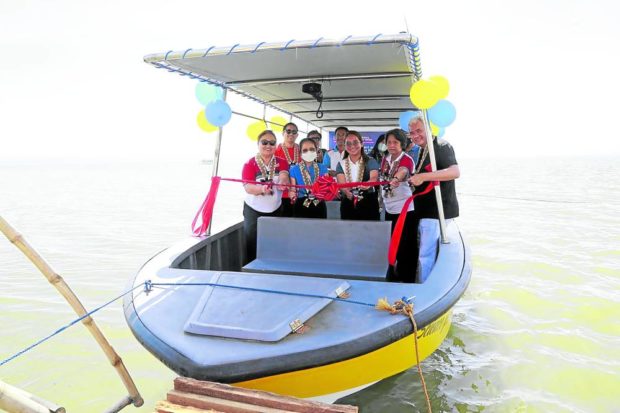Mapua-DOST team develops tech for small fisherfolk, LGUs

HIGH-TECH BOATS | Mapua engineers, with the Department of Science and Technology, developed the “Eyes At Sea” project for collision avoidance among vessels at sea. But the goal expanded to include search-and-rescue and coastline protection, as shown during a test of the new system in waters off Quezon. (Photo courtesy of DOST-CALABARZON)
MANILA, Philippines — For fisherfolk who venture out to sea on small boats, staying safe while navigating open waters requires keeping off the path of big ships, to whom their puny craft would appear as mere specks on the horizon, practically invisible.
This is why engineers from Mapua University have developed an initiative they aptly called “Eyes At Sea,” which uses a homegrown automated identification system (AIS) that enables boats of their scale to detect each other’s proximity and local authorities to keep track of the vessels’ location during emergencies.
At present, only international vessels — like ships that weigh 300 gross tons and passenger liners — are required by the Maritime Industry Authority (Marina) to have AIS.
At first, Mapua and De La Salle University worked on the technology in partnership with the Department of Science and Technology-Philippine Council for Industry, Energy and Emerging Technology Research and Development (DOST-PCIEERD). Then Mapua developed its own system with DOST-Calabarzon.
They hope to equip smaller boats with the system for the benefit of local fishermen and to convince both the national and local governments to rethink maritime safety standards to better protect seafarers.

PHOTO COURTESY OF DOST-CALABARZON
First in the Philippines
“Eyes” is the first of its kind to be developed in the Philippines, according to project leader Febus Reidj Cruz, a Mapua engineering professor.
Since early this month, the group has started testing the system on fiberglass rescue vessels deployed by the DOST-Calabarzon to four island municipalities dotting the southern tip of Luzon: Polillo Island, Perez, and Quezon towns in Quezon province, and Tingloy in Batangas province.
The four towns often needed emergency transport, especially during calamities, said Emelita Bagsit, the region’s DOST director.
The fiberglass boats — which at 20 knots run faster than ordinary fishing vessels — were part of efforts to “find innovative solutions” to community needs through research and development (R&D).
The project was so far the only initiative on record to equip locally deployed boats with AIS, which is usually reserved for larger vessels.
Bagsit said the system was customized in partnership with Marina to “level up the monitoring and tracking of sea vessels to ensure their safety at sea.”
The AIS basically uses the global positioning system coordinates of a vessel, as well as radio transmissions, to exchange real-time data with other ships and maritime authorities.
Cruz and three other researchers — Bryx William Garcia, Ryan Christopher Gania, and Jared Christian Nob — received funding from the DOST-PCIEERD in 2017 and finished developing the system three years later.
Last year, they secured the support of the DOST-Calabarzon in deploying AIS-equipped rescue boats in the region’s remotest towns.
Eyes At Sea’s features include a monitoring and broadcasting system that provides a vessel’s identification, position and course, speed and other navigational data.

PHOTO COURTESY OF DOST-CALABARZON
Collision avoidance
Cruz said the AIS was, at first, mainly developed for collision avoidance. Other features were added later on.
For one, he said, the system allows authorities to monitor vessel activities on the coastline.
It can also be used for marine search and rescue operations and interisland transport, he added.
“This is important because there are times when [rescue] teams need help themselves,” Cruz said, recalling an incident last month in Bulacan province where five rescuers died while on a mission in a flooded neighborhood at the height of Typhoon “Karding” (international name: Noru).
“This would also allow local government units (LGUs) to monitor their own assets and resources,” Cruz said.
AIS-equipped vessels are also better suited for patrolling municipal waters, especially against illegal fishing, Bagsit said.
The DOST official said the Eyes project could use some more support to make it available to more LGUs.
Taking a gamble
“Essentially, we’re taking a gamble… to show Filipinos that local technologies work,” Bagsit said. “Eventually we also hope to encourage both the national and local government to prioritize our local R&D.”
At present, AIS instruments developed abroad cost at least P150,000.
While the Mapua-DOST team has yet to set a market price for Eyes At Sea, Cruz said its cost of production was about 20-percent less than that of its foreign-made versions.
Ultimately, the engineers hope to convince Marina to rethink its guidelines and integrate the system in its operations.
The team also plans to talk with fishing communities to get them interested in the technology.
“We want smaller vessels to use this because, more likely than not, they don’t have such systems in place,” Cruz said, adding: “We want to innovate on existing technology and redesign it so it could be useful to communities.”
RELATED STORIES
Gov’t urged to install devices to aid in safe sea navigation
‘Frustrated scientist’ Bongbong Marcos cites benefits of science and technology